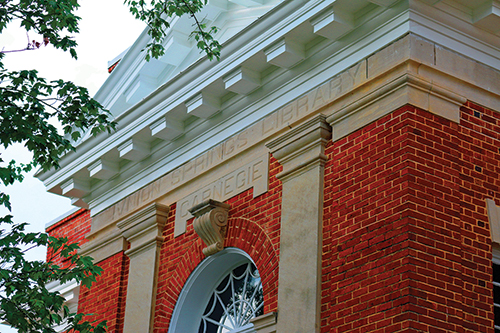
By Marilyn Jones
I had just finished touring the Bessemer Hall of History Museum when my tour guide, Trisston Burrows, asked if I knew they also had a Carnegie Library. “It now serves as the chamber of commerce office and we’re very proud of it.”
I drove the few blocks to see what once served as its library. A stately brick building might not seem like a springboard of curiosity for some, but I was immediately interested — why would a Pennsylvania industrialist build a library in Bessemer, Alabama?
Andrew Carnegie
During the last 18 years of his life, Scottish-American Andrew Carnegie gave away nearly 90 percent of his steel industry wealth ($350 million equaling billions today) to charities, foundations, universities and communities to build libraries.
In the closing years of the 19th century and early years of the 20th century, a total of 2,509 Carnegie libraries were built around the world, 1,689 in the U.S. Alabama was the recipient of 19 library building grants, including five on university campuses. By the time the last grant was made in 1919, there were 3,500 libraries in the United States; nearly half of them were built with construction grants paid by Carnegie.
In Alabama, ten have been converted for other use and seven razed. Only two are still being used as libraries — in Eufaula and Union Springs.
Why libraries?
Books and libraries were important to Carnegie, beginning with his early childhood in Scotland and his teen years in Allegheny/Pittsburgh. There he listened to readings and discussions of books from the Tradesman’s Subscription Library, which his father helped establish. Later, while working for the local telegraph company, Carnegie borrowed books from his employer.
In his autobiography, Carnegie describes his personal experience as an immigrant who, with help from others, worked his way into a position of wealth. This reinforced his belief in a society based on merit, where anyone who worked hard could become successful. This conviction was a major element of his philosophy of giving in general and of his libraries as its best known expression.
Eufaula
The Eufaula Carnegie Library, 317 Eufaula Ave., looks like a grand mansion, with its two-story brick facade and yellow trim. An arched windowpane of colored glass adorns the space above the west entrance. A gabled portico, with a set of round Doric columns, welcomes patrons to the north entrance.
Built at a cost of $10,000 in 1903 and 1904, the city council agreed to pay $1,000 a year for its operation. It was Carnegie’s method to build and equip the libraries, but only on condition that the local authority match that by providing the land and a budget for operation and maintenance.
“The two front rooms of the library, now used as the genealogy, local history room and director’s office, feature identical corner fireplaces and high wooden mantels supported by Ionic columns,” says Ryan McCollough, communications coordinator for the Eufaula Barbour County Chamber of Commerce.
Another outstanding feature, McCollough says, is the library’s large second-floor auditorium. “In the library’s early years, the auditorium was the scene of high school graduation ceremonies, dances and other public events.”
Eufaula, a city of just over 13,000, is also known for its other historic buildings, many listed on the National Register of Historic Places. The Seth Lore and Irwinton Historic District, with 667 contributing properties, is the second-largest historic district in the state.

Photo courtesy Tourism Council of Bullock County
Union Springs
The architectural design of the Union Springs Carnegie Library, 103 North Prairie St., is Classic Revival-Beaux arts.
Efforts to open a library began in the late 1800s when the Ladies’ Lyceum was formed. After two years of fundraisers to buy 332 books, the library opened in the basement of the Baptist Church. Members paid $2 a year to borrow books. The library was open four hours a week with members of the lyceum volunteering to serve as librarian.
After the turn of the century, Miss Molly Norman wrote to Andrew Carnegie asking for help in building a public library. After city council appropriated $1,000 a year as operating funds, Carnegie approved a $7,000 grant for construction, which began in 1911.
Completely restored in 2010, the library features original antique furniture, light fixtures and mahogany woodwork. Like Eufaula, the library features a stage, dressing rooms and movie projection room on the lower level used over the past century for public events.
Union Springs has an unusual wealth of historic homes, businesses and monuments for a community of less than 4,000. On the city tour there are 48 stops. From an 1851 log cabin and Bullock County Courthouse (1871-1872) to the 1852 antebellum Foster-Chapman House, said to be the finest surviving example of the Moorish Revival style, the city offers a plethora of interesting destinations along its tree-lined streets.
It is a treasure for the state of Alabama to have two Carnegie libraries. Maintained by communities with a respect of history, they continue to fulfill their original mission to make books available, as was Carnegie’s wish.
Other library sites Used for a different purpose:
- Bessemer
- Decatur
- Montgomery
- Selma
- Talladega
- Troy
- Alabama A&M
- Alabama Polytechnic Institute
- Judson College
- Tuskegee University
- No longer standing:
- Anniston
- Avondale
- Ensley
- Gadsden
- Huntsville
- West End
- Talladega College




